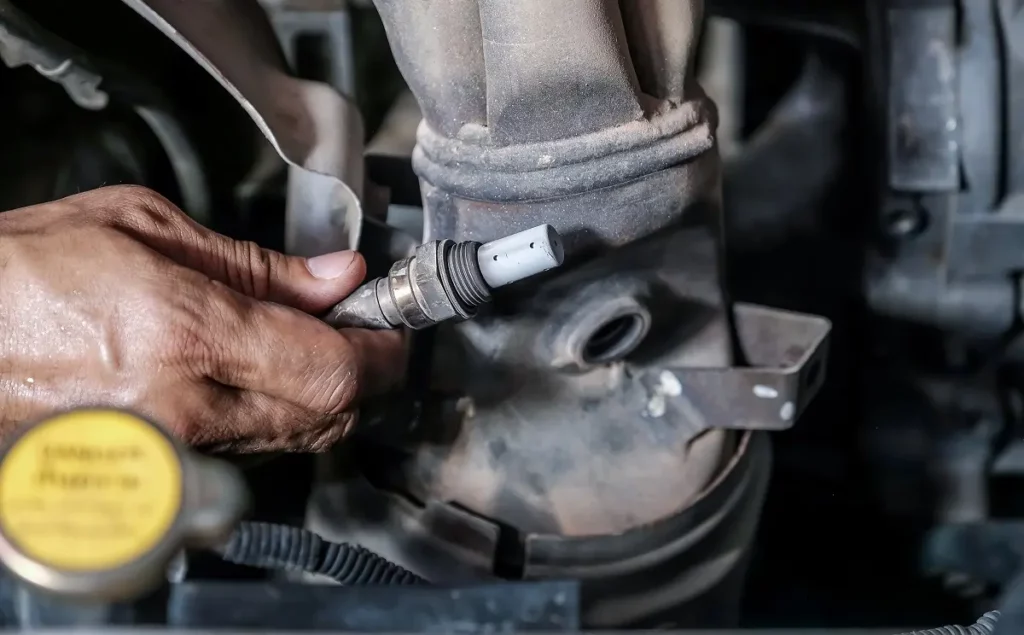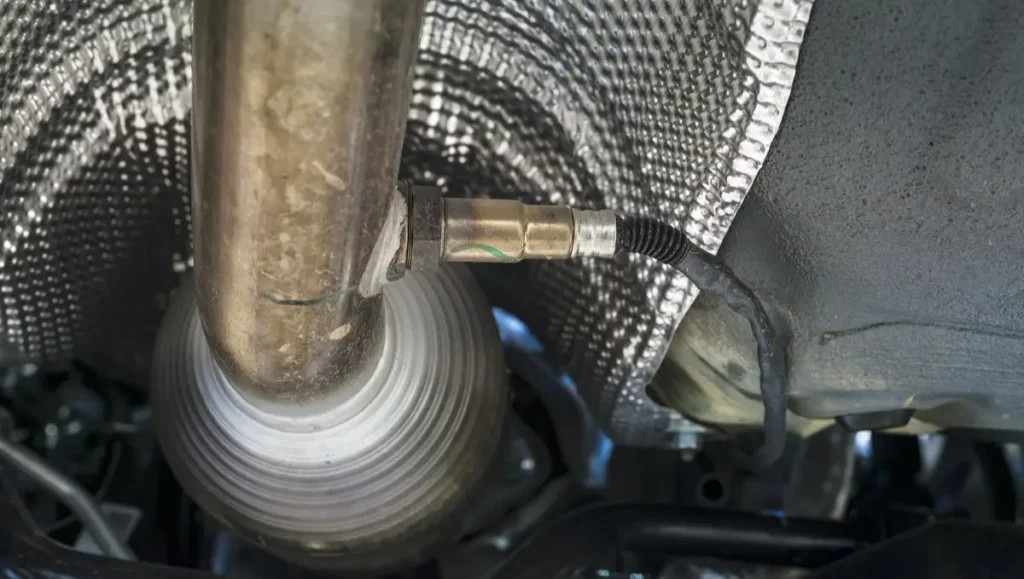Modern cars are fitted with hundreds of different sensors that are directly connected to the ECU. With information from sensors, the ECU controls the engine and other vital systems. If one or more sensors are faulty, a lot can go wrong with the car.
In this article, we’ll talk about an O2 sensor-related code, specifically, the P0146 check engine light code. We’ll cover everything you need to know about this fault code including what it means, what are the most common causes, what are the most common symptoms, how to diagnose the P0146 code, and how to fix it.

What Does The P0146 Code Mean?
The P0146 code stands for O2 sensor with no activity detected. What this means is that the ECU has detected an issue with oxygen sensor 3 in bank 1. The P0146 tells us that the sensor isn’t working as it should. It can be caused by a number of reasons, which we’ll cover later in the article.
The sensor in question is the oxygen sensor located after the catalytic converter. This particular sensor is used to monitor the efficiency of the catalytic converter.
P0146 Fault Code Symptoms
The P0146 DTC is specific in terms of symptoms. One symptom that’s common for all car brands is an illuminated check engine light.
Unfortunately, an illuminated check engine light doesn’t help in diagnosing the issue, but it does tell the driver that there’s an issue with the car.
Another symptom to look out for is increased fuel consumption. Although the O2 sensor 3 doesn’t affect the air-to-fuel ratio in any way, certain makes and models may show increased fuel consumption due to this specific trouble code.
A rougher idle is also a symptom that can point to the P0146 fault code. Just like with the previous symptom, it’s not related to the air-to-fuel mixture, but some cars show this symptom.
Lastly, you can notice excessive smoke coming from the exhaust. This isn’t caused by the faulty sensor, but rather by the ECU that is adjusting the fuel trim in order to compensate for the lack of information from the affected O2 sensor.
What Are The Most Common Causes For The P0146 DTC?
Thankfully, there are only a few possible causes for the P0146 fault code. These include faulty wiring, a faulty oxygen sensor, and a faulty ECU.
Faulty Wiring Harness
Faulty or defective wiring is one of the most common causes of the P0146 code, especially in older cars. Because the wiring for the oxygen sensor on position 3, bank 1 is located in a place that has frequent heat cycles, it’s normal for these wires to become fragile and prone to breaking. This also applies to the connectors.
Faulty Oxygen Sensor
A faulty oxygen sensor is the most common cause of the P0146 DTC. Although most European cars use highly durable oxygen sensors, it’s not an uncommon occurrence for an oxygen sensor to become faulty.
A faulty oxygen sensor will usually cause all the symptoms we mentioned.
Faulty ECU
A faulty ECU is another possible cause of the P0146 fault code. Although it’s unlikely that it will cause only the P0146 code to appear, it’s still worth checking out. A faulty ECU will likely cause a series of other fault codes and symptoms.
How To Diagnose The P0146 Fault Code?

There are a couple of things you’ll need to do in order to successfully diagnose the P0146 code. Some of the steps in diagnosing this fault code are similar to diagnosing other fault codes but are a necessary step either way.
Scan Your Car With an OBD II Scanner
Diagnosing any fault code starts with connecting your OBD II scanner to the ECU. It’s important to make sure which fault codes are stored in the ECU because it can help you in fixing the issue. There are a lot of situations where a problem causes additional fault codes to appear.
Visually Inspect Wiring and Connectors
If the P0146 fault code is the only one stored in your car’s ECU, the next step to successfully diagnosing this fault code includes visually inspecting the wiring and connectors that lead to the oxygen sensor on position 3.
Damaged wiring and connectors are a common problem in older cars, and should be thoroughly inspected before jumping to conclusions. Not only is it more affordable to repair a broken wire or connector, but it’s essential in fixing the issue altogether.
The connectors should be thoroughly inspected for corrosion. Corroded connectors can also be a cause for the P0146 DTC code.
Check The Oxygen Sensor
If the wiring is in good condition, the next thing to check is the oxygen sensor. There are two options for checking the oxygen sensor. The simpler way of checking the oxygen sensor is by monitoring real-time values with your OBD II scan tool. While your engine is idling at around 2,000 RPM, the voltage coming from the O2 sensor should rapidly change. If the voltage isn’t responding, it’s a clear sign that the O2 sensor should be replaced.
If you don’t have the required software or an OBD II scanner with advanced monitoring options, you can check the oxygen sensor by using a multimeter.
Hopefully, one of these inspections will show what caused the P0146 to get triggered. If everything is in good condition, it’s likely that your ECU is causing the issue, which is also the most expensive fix.
How To Fix P0146?

Due to the limited number of things that can cause the P0146, there’s also a limited number of options when it comes to fixing the P0146 DTC code.
Repairing Damaged Wires and Connectors
If defective wiring or connectors caused the P0146 fault code to be triggered, you’ll need to find the damaged part of the wire, strip it down, solder it back together, and insulate it. If this was the cause for triggering the P0146, repairing the wires should fix the issue. Corroded connectors can also be the cause, so make sure to check all the connectors for corrosion or damage. Remove the affected connector and replace it with a new one.
Replace The Faulty Oxygen Sensor With A New One
Another possible fix for the P0146 fault code is replacing the affected oxygen sensor with a new one. Unfortunately, faulty oxygen sensors can’t be repaired, only replaced. If this is the cause for the P0146 DTC, make sure to get a new oxygen sensor from a reputable aftermarket manufacturer, or a genuine part. Replacement should be a straightforward process on most cars. Check our catalog for quality oxygen sensors made by some of the best brands in the business!
Replace The ECU
The last possible solution to fixing the P0146 code is to replace the entire ECU. Because this is the most expensive and complicated solution, make sure you’ve checked every other option. Some car brands require a specific ECU installation process, so make sure you’ve checked the owner’s manual before attempting this type of repair.
Use High-Quality Oxygen Sensors to Fix the P0146 Code
If you’re interested in fixing the P0146 fault code by yourself, make sure to use genuine or high-quality aftermarket parts. You can find all the parts you need to fix the P0146 fault code at eEuroparts.com. Even though the selection of replacement parts is huge, you’ll have no trouble finding the right part once you select the year, make, and model of your car.
The reason why so many people choose eEuroparts.com to get replacement parts is the fact that the catalog includes only high-quality parts from reputable brands.


